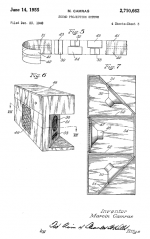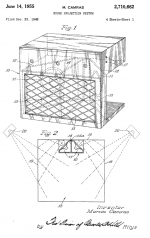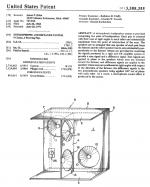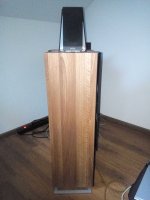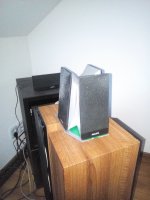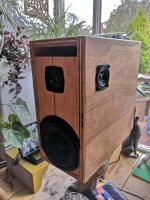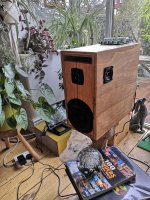How would this work, using Elias's ideas?
the rear speakers bouncing off the wall, the forward speaker low passed:
(I'm thinking of a desktop situation)
Ok, reinventing the wheel
.
Attachments
This guy is doing something similar Home - Aspen Pittman Designs
Aspen Pittman Designs Monitoare-PA Active – Thomann România
This kind of mid-side speaker has been around quite a while, too. This example 1968
.
Attachments
Very cool system Elias! I have to try this out!
Please do report your findings
Its very simple to use stereo amp and connect the speakers like the matrix, but this messes up speaker response if the speakers are multiway with passive crossovers?
As long as the three speakers are identical, the speaker impedance does not matter. Speaker signals are defined by impedance ratios, and if you do the math you will see the impedances are canceled out in the matrix equation.
.
Hi,
I bought some cheap small full range drivers ( Vifa TC9 ) and I'm building my third prototype now
At first I tried a open baffle setup like the James P Holm patent you posted with MS encoded stereo signal. Kind of worked, but needs the encoding done before amp so quickly moved forward to try Elias star connection First did quick test with the open baffle thingy, but it didn't have much effect the side drivers radiating both ways.
First did quick test with the open baffle thingy, but it didn't have much effect the side drivers radiating both ways.
Next I made a simple enclosed box out of lumber from house renovation leftovers. All drivers sharing the same volume (similar to Elias proto) and it worked great for the stereophonic / spacial effect. So much so I ordered some plywood for proper cabinet and resistors and capacitors to try to adjust apparent treble width.
What I've tried so far, without the psychoacoustic filter at least, the spacial effect gets narrower towards upper frequencies and locates the speaker and just somehow takes a way from the otherwise seemingly big sound stage. With the prototype I got best spacial effect tilting the cabinet back so that the center channel more or less bounced from the ceiling with less direct sound, but this takes a way the definition from the center Of course the proto cabinet is far from perfect and the speaker is beaming highs etc. Next up a prototype where I try to make the center speaker treble dispersion wider and try the psychoacoustic filter to adjust between "definition" and apparent width.
Of course the proto cabinet is far from perfect and the speaker is beaming highs etc. Next up a prototype where I try to make the center speaker treble dispersion wider and try the psychoacoustic filter to adjust between "definition" and apparent width.
Then what ever works for the center I want to find out how much the side speaker position and orientation relative to the center speaker and back wall affects the sound in my living room. And then try to make the all three speakers into a smallest possible single unit since this has to fit behind the television, or hanging above it.
Nevertheless this is great speaker concept to listen to for background music and television when there is no time or space to properly set a conventional stereo setup at home. For 50€ invested so far its been a lot of fun
Sorry, I don't have any measurement equipment and I don't intent to take this journey too scientific. I'm hobbying this by ear to make a enjoyable soundstage at home for the background bossa nova
I bought some cheap small full range drivers ( Vifa TC9 ) and I'm building my third prototype now
At first I tried a open baffle setup like the James P Holm patent you posted with MS encoded stereo signal. Kind of worked, but needs the encoding done before amp so quickly moved forward to try Elias star connection
Next I made a simple enclosed box out of lumber from house renovation leftovers. All drivers sharing the same volume (similar to Elias proto) and it worked great for the stereophonic / spacial effect. So much so I ordered some plywood for proper cabinet and resistors and capacitors to try to adjust apparent treble width.
What I've tried so far, without the psychoacoustic filter at least, the spacial effect gets narrower towards upper frequencies and locates the speaker and just somehow takes a way from the otherwise seemingly big sound stage. With the prototype I got best spacial effect tilting the cabinet back so that the center channel more or less bounced from the ceiling with less direct sound, but this takes a way the definition from the center
Then what ever works for the center I want to find out how much the side speaker position and orientation relative to the center speaker and back wall affects the sound in my living room. And then try to make the all three speakers into a smallest possible single unit since this has to fit behind the television, or hanging above it.
Nevertheless this is great speaker concept to listen to for background music and television when there is no time or space to properly set a conventional stereo setup at home. For 50€ invested so far its been a lot of fun
Sorry, I don't have any measurement equipment and I don't intent to take this journey too scientific. I'm hobbying this by ear to make a enjoyable soundstage at home for the background bossa nova
For the center channel to get dispersion, use two flaps mounted on stiff hinges relatively close together. Exactly like an open book facing up or a butterfly, but with a gab where the spine would be.
The gab is to let a certain amount of direct sound through.
It’s works kind of like a multicell horn, only much simpler, with little compression and only three cells.
But it works so well that it’s semi permanent on my main speakers.
Hinged flaps lets you adjust for taste and asymmetry in the room.
The gab is to let a certain amount of direct sound through.
It’s works kind of like a multicell horn, only much simpler, with little compression and only three cells.
But it works so well that it’s semi permanent on my main speakers.
Hinged flaps lets you adjust for taste and asymmetry in the room.
For the center channel to get dispersion, use two flaps mounted on stiff hinges relatively close together. Exactly like an open book facing up or a butterfly, but with a gab where the spine would be.
The gab is to let a certain amount of direct sound through.
It’s works kind of like a multicell horn, only much simpler, with little compression and only three cells.
But it works so well that it’s semi permanent on my main speakers.
Hinged flaps lets you adjust for taste and asymmetry in the room.
can you post some pics?

squeak, thanks for the tip! Will try that one out with quick cardboard mockup someday  I built one mini karlsonator for the center channel, which should have similar effect with the "k-aperture". Finished it yesterday but haven't got time to listen to it much yet. Maybe next week.
I built one mini karlsonator for the center channel, which should have similar effect with the "k-aperture". Finished it yesterday but haven't got time to listen to it much yet. Maybe next week.
Mini Karlsonator (0.53X) with Dual TC9FD's
Mini Karlsonator (0.53X) with Dual TC9FD's
The psychoacoustic filter is very good improvement for the sound. I've installed it 30minutes ago and enjoying very much  have to tinker with the values someday when i've got time. I think the 0.5x multiplier in the matrix could be a little higher as well. I don't know yet how to alter that electronically so will use three amps with computer DAW to test out someday.
have to tinker with the values someday when i've got time. I think the 0.5x multiplier in the matrix could be a little higher as well. I don't know yet how to alter that electronically so will use three amps with computer DAW to test out someday.
Thanks Elias, most impressive 50e system i've heard
Thanks Elias, most impressive 50e system i've heard
Some tests, after years
I put together three small speakers that were leftovers from a cheap HT system and wired them in the star configuration. I was quite happy with the result, instead of the psycho-acoustic filter I used a piece of paper blocking the treble. Definitely very good for background music, they will be installed in my workshop.
This experiment was enforced by my unhappiness with the speakers I had, Dali Zensor 5. Even when moved around the room, I could not find an enjoyable spot. I tried to place them side by side in the middle with speakers facing to the sides and I was really surprised with the result. Suddenly, I could tell the placement of single drums and cymbals, hear details like rim hits on toms, etc. And all that in almost whole room, amazing. I did not really miss the direct sound.
There are now two pictures as attachment.
I put together three small speakers that were leftovers from a cheap HT system and wired them in the star configuration. I was quite happy with the result, instead of the psycho-acoustic filter I used a piece of paper blocking the treble. Definitely very good for background music, they will be installed in my workshop.
This experiment was enforced by my unhappiness with the speakers I had, Dali Zensor 5. Even when moved around the room, I could not find an enjoyable spot. I tried to place them side by side in the middle with speakers facing to the sides and I was really surprised with the result. Suddenly, I could tell the placement of single drums and cymbals, hear details like rim hits on toms, etc. And all that in almost whole room, amazing. I did not really miss the direct sound.
There are now two pictures as attachment.
Attachments
Last edited:
I wonder if the miniDSP 2x4 could be used for this - 3 x matrix output with variable coefficient + variable psychoacoustic filter at the center speaker + 1 x mono subwoofer with EQ for e.g. sealed or bipole compensation. And of course, hi-pass and lo-pass for the crossover.
I am afraid this is not possible with the existing plugins.
I am afraid this is not possible with the existing plugins.
It must be due to the cheap drivers and/or openness of my room, but this test arrangement does not work too well. I am at the moment very happy with a pair of Lowther DX2 in Hedlund horns in a traditional stereo triangle. The loudspeakers disappear and there is only soundstage in front of me. This SSS arrangement IMHO needs proper room (with walls at the sides, not open as mine - staircase and wide opening into other room on the other side), proper placement. My goal is most probably the "disappearing of speakers". Maybe one day I will get back to this with some high quality drivers. And definitely with DSP processing as the passive way is too limiting.
with matrix x=.5 you give a starting point of Rps = 4.7ohm and Cps = 4.7uF. (Stereophonic Sound from a Single Loudspeaker)
in the (http://elias.altervista.org/html/3_speaker_matrix.html) you give the optimal matrix x=.8333, correct?
so what are the 'starting point' values of Rps & Cps (6.7 ohms & 6.7 uF)?
in the (http://elias.altervista.org/html/3_speaker_matrix.html) you give the optimal matrix x=.8333, correct?
so what are the 'starting point' values of Rps & Cps (6.7 ohms & 6.7 uF)?
SSS listening distance
Apologies to resurrect this thread; I want to make sure Elias and fans of SSS see my question.
The geometry of my listening room is great for SSS. However, I am forced to sit closer to the front wall then I would like, due to a structural column in the middle of my room. I can easily manage the traditional stereo triangle, but not SSS.
I’m going to try three experiments to see if I can mitigate the effects of being too close to the center channel, relative to the sidewalls.:
1). Further reduce the output of the center speaker (trading intensity for time). However this is not ideal, as there are psychoacoustic limits for how much time/intensity trading one can do.
2). Place the center channel on the front wall, with the side channel speakers several feet from the front wall in order to introduce some center channel delay. While this departs from one-box approach, it certainly is in the functional spirit of the SSS matrix.
3). one SSS box, several feet from the front wall, but firing the center channel toward the front wall such that it will be reflected and delayed. While this could make the center channel a little diffuse, it will enable one to adjust the relative timing between center and sides to perfection. Also, this approach will reduce or even eliminate the need for the psychoacoustic filter, as the reflected center signal will be both lower in level AND reduced at higher frequencies than when direct. *IF* the speakers are made quite directional, (making the actual location of the box un-detectable) the result might be quite good. Again, the key here will be making all 3 channels directional to a pretty low frequency. Fullranges in shallow waveguides the size of your prototype SSS would be very directional down to lower midrange frequencies.
....a minimum distance between the speaker and the listener which can be approximately determined from the circle coinciding the speaker, the two side walls and the listener, like in this pic:
If the distance is considerably too small, sound seems to come mainly from the speaker apparently because proportional level of side wall reflections is too weak.
In my 25 m2 room there seems to be a listening area about 2 m in diameter where the sound do not change much and enjoyable listening experience is expected.
- Elias
Apologies to resurrect this thread; I want to make sure Elias and fans of SSS see my question.
The geometry of my listening room is great for SSS. However, I am forced to sit closer to the front wall then I would like, due to a structural column in the middle of my room. I can easily manage the traditional stereo triangle, but not SSS.
I’m going to try three experiments to see if I can mitigate the effects of being too close to the center channel, relative to the sidewalls.:
1). Further reduce the output of the center speaker (trading intensity for time). However this is not ideal, as there are psychoacoustic limits for how much time/intensity trading one can do.
2). Place the center channel on the front wall, with the side channel speakers several feet from the front wall in order to introduce some center channel delay. While this departs from one-box approach, it certainly is in the functional spirit of the SSS matrix.
3). one SSS box, several feet from the front wall, but firing the center channel toward the front wall such that it will be reflected and delayed. While this could make the center channel a little diffuse, it will enable one to adjust the relative timing between center and sides to perfection. Also, this approach will reduce or even eliminate the need for the psychoacoustic filter, as the reflected center signal will be both lower in level AND reduced at higher frequencies than when direct. *IF* the speakers are made quite directional, (making the actual location of the box un-detectable) the result might be quite good. Again, the key here will be making all 3 channels directional to a pretty low frequency. Fullranges in shallow waveguides the size of your prototype SSS would be very directional down to lower midrange frequencies.
Another alternative:
4). Three separate speakers. Sides moved closer to sidewalls, to restore the relative delay and level. Again, not a single box, but fully in keeping with the functionality of the SSS matrix.
5). Last resort: three “regular” front channels with the x=0.5matrix. Won’t have the coherence of SSS, but still better than 2 channel stereo.
— Mark
4). Three separate speakers. Sides moved closer to sidewalls, to restore the relative delay and level. Again, not a single box, but fully in keeping with the functionality of the SSS matrix.
5). Last resort: three “regular” front channels with the x=0.5matrix. Won’t have the coherence of SSS, but still better than 2 channel stereo.
— Mark
Thanks to Elias for this great set up.
I have built a fine sounding 2.1 version of this arrangement, using the super cheap Visaton FR8's with a peerless SLS-P830945 for bass. I've had trouble trying to source a correct amp for this project. After a bad experience with Chinese ebay-ers I was wondering if anyone had a recommendation. Either off-the-shelf or a someone who could build something bespoke.
What are people running these on?
Running it of a spare 3116 2.1 with a built in high-pass it sounds fabulous, except on resonant sounds like piano where inevitably there's some break up in the amp. I've got a 4.7 cap and 8ohm resistor, which seems to balance well for my box.
I have built a fine sounding 2.1 version of this arrangement, using the super cheap Visaton FR8's with a peerless SLS-P830945 for bass. I've had trouble trying to source a correct amp for this project. After a bad experience with Chinese ebay-ers I was wondering if anyone had a recommendation. Either off-the-shelf or a someone who could build something bespoke.
What are people running these on?
Running it of a spare 3116 2.1 with a built in high-pass it sounds fabulous, except on resonant sounds like piano where inevitably there's some break up in the amp. I've got a 4.7 cap and 8ohm resistor, which seems to balance well for my box.
Here's the prototype. Would love to get the amplifier situation all within the box, running bluetooth. The full rangers have their own separate enclosure within the main box. Not sure if it would be called a TL or a BR with a long port.
I have a LM3886 2.1 amp running on my main system, but its BTL which I read somewhere does not take the combined ground signals.
I have a LM3886 2.1 amp running on my main system, but its BTL which I read somewhere does not take the combined ground signals.
Attachments
- Home
- Loudspeakers
- Multi-Way
- Stereophonic Sound from a Single Loudspeaker
